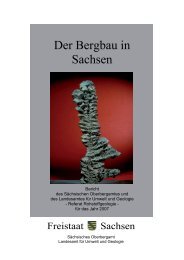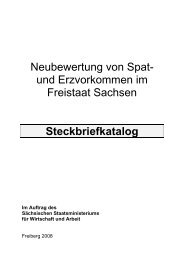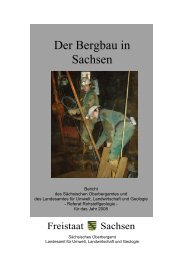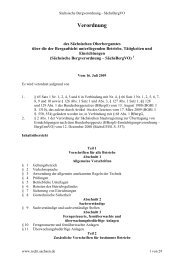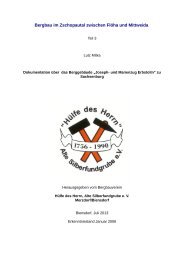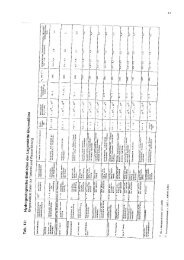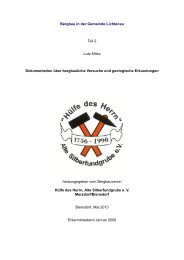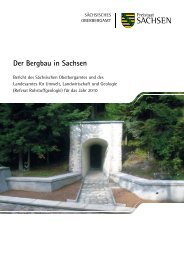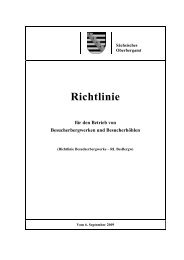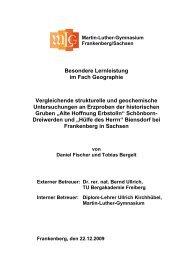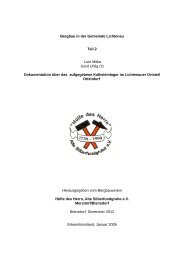Das Döhlener Becken bei Dresden - Unbekannter Bergbau
Das Döhlener Becken bei Dresden - Unbekannter Bergbau
Das Döhlener Becken bei Dresden - Unbekannter Bergbau
Sie wollen auch ein ePaper? Erhöhen Sie die Reichweite Ihrer Titel.
YUMPU macht aus Druck-PDFs automatisch weboptimierte ePaper, die Google liebt.
Abbau, zur Förderung, Wasserhaltung, Wetterführung,<br />
radiometrischen Aufbereitung und Haldenwirtschaft im ehemaligen<br />
<strong>Bergbau</strong>betrieb „W. Agatz“. Methoden der geologischen<br />
Dokumentation und der untertägigen Vorratserkundung<br />
durch den Geologischen Dienst werden erläutert.<br />
<strong>Das</strong> Ende der Urangewinnung durch die SDAG Wismut<br />
bedeutete das Ende von 447 Jahren aktiven <strong>Bergbau</strong>s im<br />
<strong>Döhlener</strong> <strong>Becken</strong>. Die bergbaulichen Ar<strong>bei</strong>ten sind damit<br />
aber noch nicht endgültig abgeschlossen. Erhebliche<br />
Aufwendungen sind erforderlich, um die <strong>Bergbau</strong>anlagen<br />
aus der Bergaufsicht entlassen zu können. Der<br />
Nachfolgebetrieb WISMUT GmbH verantwortet seit 1990<br />
die Verwahrung und Sanierung der Hinterlassenschaften<br />
des ehemaligen BB „W. Agatz“. Mit der Erar<strong>bei</strong>tung des<br />
WISMUT-Umweltkatasters wurden Grundlagen zur<br />
Verwahrung und Sanierung geschaffen. Beschrieben werden<br />
die geplanten und bereits abgeschlossenen<br />
Sanierungs- und Verwahrungsar<strong>bei</strong>ten. Besonders ausführlich<br />
wird die Flutung des Grubengebäudes behandelt, die<br />
mit dem Erscheinungszeitpunkt dieser Monographie noch<br />
nicht abgeschlossen sein wird.<br />
Zwei ehemalige Uranerzaufbereitungsanlagen mit ihren insgesamt<br />
6 Schlammteichen (IAA) im Raum <strong>Dresden</strong>/Freital<br />
unterliegen laut „Wismut-Gesetz“ nicht der Sanierungspflicht<br />
durch die WISMUT GmbH. Unter der Regie des<br />
Umweltamtes der Stadt <strong>Dresden</strong> stehen die Sanierungsund<br />
Verwahrungsar<strong>bei</strong>ten am Standort <strong>Dresden</strong>-Coschütz/<br />
Gittersee kurz vor ihrem Abschluss.<br />
Nach etwa 15 Jahren Verwahrung und Sanierung radioaktiv<br />
kontaminierter Standorte im <strong>Bergbau</strong>gebiet des <strong>Döhlener</strong><br />
<strong>Becken</strong>s sind erste positive Auswirkungen nachweisbar.<br />
Den Schluss dieser Monographie bildet eine Abhandlung<br />
über technische Denkmale und Zeugen des <strong>Bergbau</strong>s sowie<br />
die bisherigen Bemühungen und geplanten Maßnahmen<br />
zu deren Erhaltung und Erneuerung.<br />
Summary<br />
Thorough investigation of the origin of the Döhlen Basin, its<br />
extent and mineral resources began around 1800. Most<br />
noteworthy are the large comprehensive works published<br />
by C.F. NAUMANN and B. V. COTTA (1845), R. HAUSSE (1892) and<br />
H. HARTUNG (1906).<br />
This monograph on the Döhlen Basin covers a period of mining<br />
that lasted without interruption from 1542 to 1989. During<br />
that time, materials as diverse as coal, copper, alum, limestone,<br />
and uranium were exploited at various occasions.<br />
Coal mining flourished particularly in the 19th century for<br />
several reasons: The nearby Freiberg ore mining and smelting<br />
works caused a huge demand for industrial fuel.<br />
Concurrently, the capital of Saxony in the immediate vicinity<br />
offered a market for coal and provided personnel with<br />
administrative and technical skills. In several instances<br />
novel mining techniques, useful for ore mining, were introduced<br />
and tested in the Royal Coal Works.<br />
The geology section of this monograph presents a comprehensive<br />
survey of the fossil flora and fauna of the<br />
Döhlen Basin. In addition to listing the species, it also considers<br />
paleoecological aspects of the biocenoses. Several<br />
biotopes and litho-facial types of plant communities are<br />
described.<br />
Some peculiar findings are worth mentioning: the famous<br />
“mass grave of saurians” (rather reptiles) contains numerous<br />
skeletons of small amphibians, the ‘giant Arthropleura’,<br />
plants of the coal swamps preserved in live position,<br />
halophile algae as well as footprints of tetrapods and invertebrates.<br />
Remarkable are the complete absence of fish and<br />
the scarcity of remnants of an advanced mesophile flora.<br />
The fossil-bearing strata are comparatively thin and do not<br />
yield much biostratigraphic information.<br />
There were four large deposition periods, partially of cyclic<br />
character. The monograph discusses the lithologies with<br />
respect to pyroclastic strata, coal petrography, facies, variety<br />
of clast composition and chert formation. Volcanic<br />
deposits are associated with andesitic volcanism tied to the<br />
Elbe River lineament and rhyolitic pyroclastic matter from<br />
outside the basin.<br />
The geochemistry, stratigraphy, tectonic setting and grades<br />
of the basin’s uranium-(vanadium-) ore deposit are published<br />
here for the first time. The deposit contains<br />
resources of about 7,000 t uranium, an equal amount of<br />
vanadium and in addition molybdenum, arsenic, lead, zinc<br />
as well as large amounts of iron as pyrite. Copper and tin<br />
are rare. Three possible primary sources of the metals are<br />
discussed, all located northwest of the basin: Older<br />
Paleozoic schists, the younger Paleozoic volcanic complexes<br />
of Tharandt and Meißen and the monzonite complex of<br />
Meißen.<br />
The monograph lists numerous minerals of the basin fill and<br />
the underlying basement. It also provides detailed information<br />
on the secondary minerals formed in the mines and<br />
burning mine waste dumps. Whawellite is found mainly in<br />
clastic dykes. It is remarkable also from a historical point of<br />
view.<br />
There is evidence of early epigenetic thermal water. Weakly<br />
metamorphosed sediments and the degree of carbonisation<br />
give some indication of the thermal gradients existing<br />
during the formation of the basin. It is assumed that the<br />
thermal regime of the basin was driven by a deep-seated<br />
crustal magma chamber. Felsic tuffs and tuffites are present<br />
in every formation of the basin fill. Their relation to volcanic<br />
events in the vicinity (Tharandt, Meißen) has not yet been<br />
established.<br />
The tectonic elements derived from mine maps, plans and<br />
cross-sections and a 3-D presentation show that the<br />
Döhlen Basin is a half graben down-faulted along a system<br />
of north-westerly trending normal faults. Only locally, i.e. in<br />
the Bannewitz area at the north-eastern edge, a monzonite<br />
rise is relatively uplifted along a south-westerly dipping normal<br />
fault causing the graben to be fully developed. In total,<br />
III



